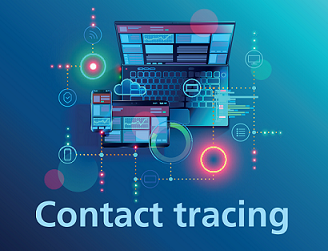Brendan Bonner, PHA, considers COVID-19 contact tracing. To view our complete series of COVID-19 blogs, click here.

Health Minister Robin Swann recently visited the pilot PHA Contact Tracing Centre in order to see first-hand the work that is being carried out to manage the next phase in the COVID-19 pandemic. Northern Ireland is the first of the devolved administrations to roll out such a plan.
Contact tracing is a monitoring and risk assessment process that is a central public-health response to infectious disease outbreaks. As the WHO outlines,[1] it can be broken down into three basic steps:
- Identifying someone who has a disease;
- Listing all those who have come into contact with the person;
- Monitoring and following up with those people.
In Northern Ireland, the contact tracing process is usually done by phone; however, in many countries digital technology is now also being used to support the tracing process, with automated approaches to tracing taking place. It is argued that the use of digital resources is potentially crucial to reducing the size of outbreaks. If effectively deployed, tech-assisted contact tracing could be part of a broader strategy for easing lockdown measures over the longer term.
A London School of Hygiene and Tropical Medicine study[2] estimates that in most scenarios, contact tracing and case isolation are enough to control a new outbreak of COVID-19 within three months. While researchers at Oxford University’s Big Data Institute[3] estimate that a combination of isolation, contact tracing and household quarantine could bring the reproduction number (R0) below 1 and control the epidemic, if tracing is instantaneous.
Despite the technical opportunities to manage the pandemic outbreak, there remains a large degree of scepticism from various quarters including political leaders, technologists and wider society. Three key challenges that have to be addressed when implementing contact tracing measures include effectiveness, population coverage and the ability of computer systems or software to exchange and make use of information and data privacy.
Public health professionals would argue that contact tracing is an essential approach in order to fight any further outbreaks. However, we also share many of the wider concerns in terms of using digital solutions which in many instances are being explored for the first time. The trade-off between the benefits of widespread automated tracing and civil liberties should be considered.
A recent rapid study undertaken by Williams et al[4] “Public attitudes towards COVID-19 contact tracing apps: A UK-based focus group study” concluded that participants were split roughly equally in number across three groups: those who will use the app, those who will not be using the app and a third group which was undecided.
The study identified five main issues that had to be considered:
- Lack of information and misconceptions;
- Privacy;
- Stigma;
- Uptake; and
- Contact tracing as the ‘greater good’.
The study found that one of the most common misconceptions about the app was that it could allow users to specifically identify and map COVID-19 cases amongst their contacts and in their vicinity.
Approaches elsewhere
Other countries such as South Korea, have used enhanced tracing measures such as GPS and location tracking alongside traditional contact tracing processes. Their government has explicitly acknowledged the intrusive nature of the tools being used, but then they are not new to this process. Following the MERS (Middle East respiratory syndrome) outbreak, a number of legislative changes were made which led to amendments to the Infectious Disease Control and Prevention Act, which gave the Minister of Health the “legal authority to collect private data, without a warrant, from both already confirmed and potential patients.”
So what next?
The Test, Trace, Protect (TTP) approach is due to be launched shortly by the Department of Health. TTP is a public health measure designed to interrupt the spread of coronavirus in the community by identifying cases, tracing people who may have been infected and supporting those close contacts to self-isolate to reduce the risk of further transmission.
The PHA have been actively contact tracing all COVID-19 positive cases since 18 May and are currently examining options around harnessing digital support to enable efficient identification of potential contacts
Phone-based apps may be able to increase speed in identifying and notifying contacts as well as increasing compliance with guidance[5], but should be considered as a complement to existing public health measures such as social distancing, outbreak investigation, and infection prevention and control procedures, for example, hand washing. It should be noted that the usefulness of any TTP approach depends on how well the public participate, and phone-based apps should be considered an adjunct to a manual TTP system
The focus will remain on that critical human contact that is being developed in Northern Ireland and public understanding of the “greater good” in terms of managing the pandemic.
To view our complete series of COVID-19 blogs, click here.
[1] www.who.int/features/qa/contact-tracing/en/
[2] www.sciencedirect.com/science/article/pii/S2214109X20300747
[3] https://science.sciencemag.org/content/early/2020/03/30/science.abb6936
[4] www.medrxiv.org/content/medrxiv/early/2020/05/18/2020.05.14.20102269.full.pdf
[5] https://royalsociety.org/news/2020/05/success-of-test-trace-and-isolate-programmes-depends-on-speed-compliance-and-monitoring/
